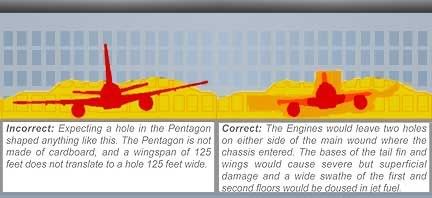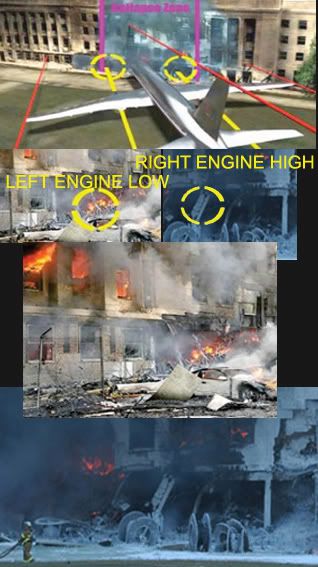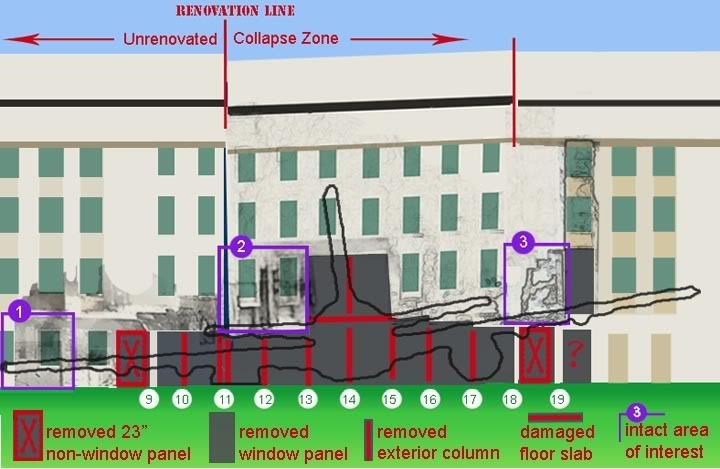Adam Larson / Caustic Logc
The Frustrating Fraud
Updated 8/30/07
Note: I first wrote this article nearly a year ago when I didn't knw as much and was on different tangents. I've updated it a few times and it's getting slapdash. I will de totally revising my ttext and graphics at some point in the near-future to make this a solid contribution rather than the mess it is.
(check also Jim Hoffman's page on common "errors" associated with the entry wound analysis.)
Perhaps the most prevalant mistake among myriad that has been repeated ad nauseam by no-plane researchers is focusing on the “small hole” in the breached outer ring. 911 In Plane Site host Dave Von Kleist reminded viewers of the dimensions of a Boeing 757 - 124 foot wingspan and 44-foot tailfin heighth - and then he explained two different versions of the hole in the Pentagon, neither of which would allow the alleged Flight 77 to pass. At one point he asked “how does a plane of those dimensions fit into a hole only 65 feet across?” and at another point “how does a 757 fit into a 16 foot hole and leave no damage, or wreckage on the outside of the pentagon?” In Loose Change, narrator Dylan Avery says “the only damage to the outer wall is a single hole no more than sixteen feet in diameter.” Others have it at 12 feet, or as low as five, and other cite a wider damage area but still deny passage to 124-foot-wide jetliner.
Both videos and may others cite the lack of holes for wings and tailfin, apparently taking their own charges of “stage-managed event” too literally, and looking for a cookie cutter punch-out of a cardboard prop shaped exactly like a plane’s profile. (note on the graphic: it was hitting not dead-on but at a 45 degree angle and so the hole would be slightly wider than the actual chassis, but no larger vertically.)

Indeed what should we expect? Well, I'm no structural engineer or other type of expert, but I have enough common sense to take my own crack at it. Let's start with the main chassis, as I did. When the nosecone hits at about 350 mph, like a bullet (or a missile!) it would easily pierced the outer wall, leaving a hole about 12-15 feet high and 16-18 feet wide.
 In the shot at left, the second floor facade breaching is limited to a perhaps twelve foot wide set of windows and section of wall, presumably taken out by the base of the tailfin. But this allows us to clearly see a bright patch of fire just a few yards in on the second floor, which is intact at that point. So whatever pierced the outer wall was large enough to take out the wall and the edge of that floor and hurl burning material across it. but since the rest of the floor is intact, clearly the object was small enough that it was instantly diverted/mangled/compressed to fit entirely beneath the second floor slab. I've been unable to verify the exact clearance even from the ASCE report, but from photo analysis it seems to have about 13-15 feet available - roughly the size to allow a barreling 12-foot-high 757 body. Note also the recognizable line of orange jet fuel fire – from left to right it progresses from ground level to piles of burning debris on the second floor. This is consistent with the alleged baking angle of the plane with starboard wing tipped high and cutting across the second floor slab, left engine basically at ground level.
In the shot at left, the second floor facade breaching is limited to a perhaps twelve foot wide set of windows and section of wall, presumably taken out by the base of the tailfin. But this allows us to clearly see a bright patch of fire just a few yards in on the second floor, which is intact at that point. So whatever pierced the outer wall was large enough to take out the wall and the edge of that floor and hurl burning material across it. but since the rest of the floor is intact, clearly the object was small enough that it was instantly diverted/mangled/compressed to fit entirely beneath the second floor slab. I've been unable to verify the exact clearance even from the ASCE report, but from photo analysis it seems to have about 13-15 feet available - roughly the size to allow a barreling 12-foot-high 757 body. Note also the recognizable line of orange jet fuel fire – from left to right it progresses from ground level to piles of burning debris on the second floor. This is consistent with the alleged baking angle of the plane with starboard wing tipped high and cutting across the second floor slab, left engine basically at ground level. Having clearly accounted for the main chassis, the question of what happened to the massive engines, which occupy a space about 50 feet wide, at first stumped me. Dense, cylindrical, with a diameter of about nine feet, would probably obliterate the outer walls and enter the building intact, in fact advancing ahead of the rest of the plane. They were, after all, what was driving the whole thing, and after tearing loose from the exploding wings their own unhindered momentum and the last second or two of fuel burning would shoot them through like blocky missiles until lack of fuel and resistance forced them to stop, likely in various pieces. Radial parts that could well be from such engines were found inside the building. On the way in, they would knock out holes, I believe, like those shown below.

Top: Still from Purdue University simulation, yellow added. Below left: knocked-out section of the first floor to the left of main entry point with fires inside and out, likely entry point for left engine. Below, right: what I had previously taken as broken and oddly tilted support columns on the first floor just to the right of main impact, likely entry point for right engine.
 ---
---(update): Many have taken these columns as signs the plane could not have entered - since they lie at the "shoulder" of the alleged plane's impact, between wing base and chassis, they could almost be right. Though it never seemed a big enough problem for me, it was troubling. It was also a bit sloppy to call these "support columns" when the three each look different and all columns on the left side were uniformly removed. Jim Hoffman has decided they are at least as likely parts of the second floor slab that broke after losing their supports and fell at this angle. I did a lengthy post on this. If these are indeed something else, then we are left with a roughly 80-100 foot-wide area in which all supports were obliterated - leaving plenty of room for the penetrating core of a 757 and explaining the collapse of everything above twenty minutes later.

Compare this to the size of the initial "hole" we see above, from a simplified computer graphic done up by the ASCE and fairly accurate. The limestone facade and essentially all outer columns are gone from an open span of it looks like nearly 100 feet of the ground floor, even with the three slants on the right that probably aren't columns. Again,plenty of room.
What I could see in this damage is a high 16 foot hole flanked by two 10-foot holes set lower amid a jumble of lesser damage. The possible engine holes seem to be about 70 feet apart, which is how far apart the engines would be if hitting at a 45 degree angle as alleged. The math is correct, and we have a roughly 100-foot damage area or “hole” with all columns removed. The plane fits – at least as far as width, but should it be able to fly or compress its entire 155-foot length inside and disappear? Well, that seems less likely, but perhaps depends on the nature of the “renovations” just completed there and on exactly how many feet of steel reinforced concrete stood in its way.
 And as for the "no plane" evidence's recycling in Loose Change, they insist on their sixteen foot hole while the shot on screen has the spray from a fire hose completely covering both this hole and the 65-foot-plus damage area around it that even IPS showed. Then they highlight the plane's outline with the chassis hole entirely on the second floor! Despite their marvelling at the plane flying "inches" above the ground, they think it deviated upward in its final feet and hit the second floor, leaving the greater damage below unexplained. I feel sorry for these guys' girlfriends - their careful analysis of the Pentagon evidence gets it in the wrong hole. And we all know it's not good to get germs from the fallacy hole in the truth canal.
And as for the "no plane" evidence's recycling in Loose Change, they insist on their sixteen foot hole while the shot on screen has the spray from a fire hose completely covering both this hole and the 65-foot-plus damage area around it that even IPS showed. Then they highlight the plane's outline with the chassis hole entirely on the second floor! Despite their marvelling at the plane flying "inches" above the ground, they think it deviated upward in its final feet and hit the second floor, leaving the greater damage below unexplained. I feel sorry for these guys' girlfriends - their careful analysis of the Pentagon evidence gets it in the wrong hole. And we all know it's not good to get germs from the fallacy hole in the truth canal.









4 comments:
OK still see no picture that shows the level of damage that you insist is behind the foam in pitures in debunkers theories
Where are they?
This is an old post with not the best graphics. Here is a site that explains it a bit better (sidebar):
http://911research.com/essays/pentagon/index.html
No one photo shows it all but this one comes closest:
http://www.aal77.com/pentagon_911_book/hole1.jpg
and here is a good composite (Italian import, not mine):
http://frustratingfraud.blogspot.com/2008/05/cookie-identification-team.html
Now it's time to ignore this much damage with 'oh, there's a column-like think over here' and 'the wall just wasn't finished' and 'I still don't see anything, it's all so confusing.'
Well, here's the damage in two parts:
Left side
Right side
Thanks Pedro, that's helpful. It is worth noting that this hole is so big there is not a single photo that shows the whole thing. Here's about the closest:
http://aal77.com/pentagon_911_book/hole1.jpg
note also 2nd floor damage at the right, where the right wing was tilted high.
Post a Comment